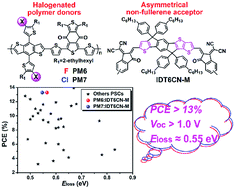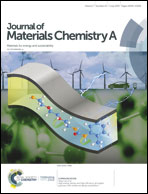Overcoming the energy loss in asymmetrical non-fullerene acceptor-based polymer solar cells by halogenation of polymer donors†
Abstract
To achieve efficient polymer solar cells (PSCs), it is important to overcome the energy loss (Eloss) from the optical bandgap to the open-circuit voltage (Voc) of the device by properly matching donor/acceptor (D/A) photovoltaic materials. Here, we develop efficient PSCs based on the absorption complementary pairs of halogenated polymer donors (PM6 and PM7) and an asymmetrical non-fullerene acceptor (IDT6CN-M). The D/A pairs of PM6:IDT6CN-M and PM7:IDT6CN-M show very small highest occupied molecular orbital offsets (ΔEHOMO) of 0.10 and 0.08 eV due to the fact that the halogenation decreases the HOMO levels of polymers, which helps the PSCs achieve a high Voc of 1.04 and 1.05 V, and a small Eloss of 0.56 and 0.55 eV, respectively. Our studies show that the D/A pairs have good morphology compatibility, and the related devices have efficient photon capture and exciton dissociation, balanced and efficient charge transfer and extraction processes. As a result, the PSCs based on PM6:IDT6CN-M and PM7:IDT6VN-M achieved the same high device efficiency of 13.3%, which is one of the highest values for single-junction PSCs with a Voc of over 1.0 V.



 Please wait while we load your content...
Please wait while we load your content...